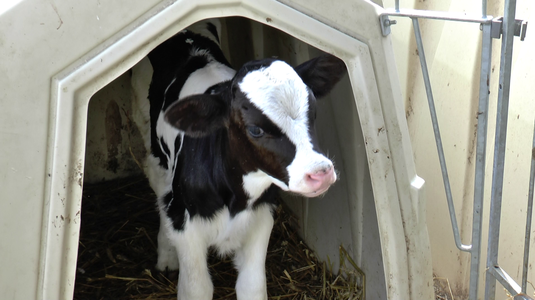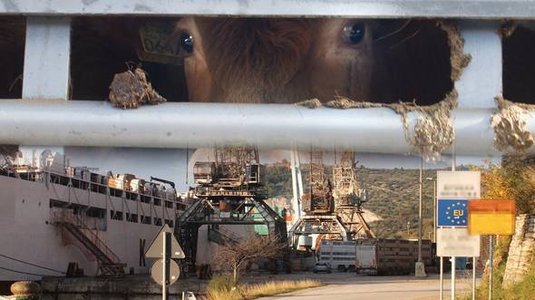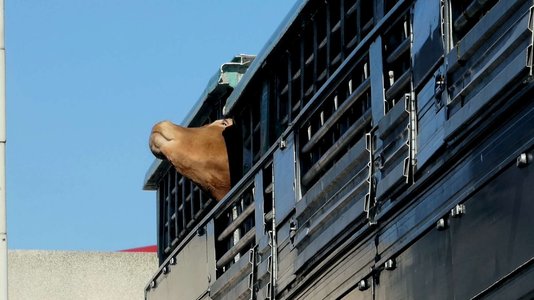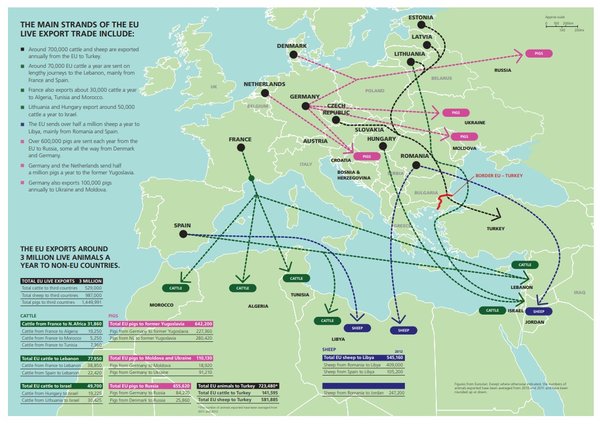Dossiers
Export of live animals: EU to non-EU countries
1. Main strands of the EU live export trade
- Around 700,000 cattle and sheep are exported annually from the EU to Turkey.
- Around 70,000 EU cattle a year are sent on lengthy journeys to the Lebanon, mainly from France and Spain.
- France also exports about 30,000 cattle a year to Algeria, Tunisia and Morocco.
- Lithuania and Hungary export around 50,000 cattle a year to Israel. The EU sends over half a million sheep a year to Libya,
mainly from Romania and Spain. - Over 600,000 pigs are sent each year from the EU to Russia, some all the way from Denmark and Germany.
- Germany and the Netherlands send half a million pigs a year to the former Yugoslavia.
- Germany also exports 100,000 pigs annually to Ukraine and Moldova.
The EU has developed a ruthless live export trade in which many animals are transported over huge distances and often suffer greatly both during the journey and on arrival at their destination. The EU exports around three million animals a year – cattle, pigs and sheep – to non-EU countries. Some of the animals are exported for slaughter, others for fattening or breeding. We believe that the EU's inhumane live export trade must be brought to an urgent end.
2. These journeys often involve massive suffering
As the long journeys wear on, the animals becomeincreasingly exhausted, dehydrated and stressed. Some are unable to withstand the rigours of the journey and get injured or sick and, in the worst cases die. Rarely do those that fall sick or injured receive any veterinary attention, but are just left to suffer and even to slowly die on the truck. The stress factors involved can include deprivation of food and water, lack of rest, overcrowding, insufficient headroom, extremes of temperature and humidity, inadequate ventilation and rough handling. We share the view of the Federation of Veterinarians of Europe which states that: “Animals should be reared as close as possible to the premises on which they are born and slaughtered as close as possible to the point of production”. The EU’s live export trade flies in the face of this fundamental principle.
3. Case Studies
1. In Turkey, investigators filmed a calf being pulled from the womb of his newly slaughtered mother. The calf’s throat was cut after just two minutes of life.
2. Investigators in israel filmed workersusing an electric goad to try and force an injured bovine to stand up. When thatdid not work, a strap was tied to theanimal’s leg and he was dragged along by a fork-lift truck.
3. In late 2012, a truck left latvia carrying 31 bulls bound for slaughter in iraq – ajourney of over 4,600 km. The truck was delayed at the border between the EU and Turkey for 6.5 days as the drivers did not have the necessary documentation to allow them to cross Turkey to Iraq. Throughout this time the animals were left cooped up on the truck. Eventually the paperwork problem was solved and, after being unloaded for a rest, the bulls began the long journey across Turkey to Iraq. in all, the journey from latvia took 13 days.
4. Delays at borders increase the risk of suffering
Particularly serious problems are caused by prolonged delays at the border between the EU and Turkey. During these delays – which can last for hours, even days – the animals are often left on the trucks frequently without adequate ventilation, food and water. They often become desperate with thirst and so hungry that they eat their own filthy bedding. Some of the animals collapse through exhaustion or injury and risk being trampled by their companions. In some cases heavily pregnant animals abort or give birth to lambs and calves in the crowded trucks. Our opposition to the live trade is based both on the detrimental impact on animal welfare of long journeys and on the poor treatment often experienced by the animals at journey’s end. We have film evidence of callous treatment in the slaughterhouses of destination countries. In many of these countries animals are not stunned – rendered unconscious –before slaughter. Their throats are cut while they are fully conscious and they are left to bleed to death.
This is the harsh world to which the EU sends its animals. Once animals leave Europe, the EU authorities are powerless to protect them as EU legislationon welfare during transport and slaughter generally does not apply outside Europe.
Stop subsidising this inhumane trade: Part of this trade – the export of breeding cattle to non-EU countries – is generously subsidised by European taxpayers. The EU pays out about 9 million Euros a year to exporters to encourage this trade. On average, 80,000 cattle a year are exported with subsidies. These subsidies must stop. Public money should not be used to promote a trade that often results in suffering.
Shockingly, the European Commission is actively trying to promote the export of live animals to non-EU countries as part of its drive to increase EU exports. Both Turkey and Russia are under pressure from the Commission to import even more animals from the EU.
Article 13 of the Treaty on the Functioning of the EU provides that, in formulating and implementing the EU’s policies on agriculture and transport, the Union and the Member States must “pay full regard to the welfare requirements of animals”. This trade pays noregard at all to the animals’ welfare and is inflagrant breach of the EU’s own Treaty.
Download:
Export of Live Animals from European Union to Non-EU Countries
This briefing has been produced by Compassion in World Farming, AWF|TSB and Eyes on Animals in January 2013.









